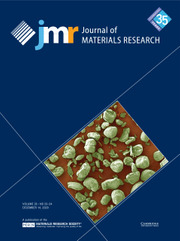Crossref Citations
This article has been cited by the following publications. This list is generated based on data provided by
Crossref.
McCoy, Michael A.
Grimes, Robin W.
and
Lee, William E.
1997.
Planar intergrowth structures in the ZnO-In2O3system.
Philosophical Magazine A,
Vol. 76,
Issue. 6,
p.
1187.
Wunderlich, W.
1998.
Atomic Structure of Symmetrical Tilt Grain Boundaries in Zinc Oxide with High Coincidence.
physica status solidi (a),
Vol. 170,
Issue. 1,
p.
99.
Lee, W. E.
McCoy, M. A.
and
Grimes, R. W.
1998.
Ceramic Microstructures.
p.
637.
Haskell, Benjamin A.
Souri, Shukri J.
and
Helfand, Martin A.
1999.
Varistor Behavior at Twin Boundaries in ZnO.
Journal of the American Ceramic Society,
Vol. 82,
Issue. 8,
p.
2106.
Sagalowicz, Laurent
Fox, Glen R
Dubois, Marc-Alexandre
Muller, Claude A.P
Muralt, Paul
and
Setter, Nava
1999.
Microstructure and defects of wurtzite structure thin films.
Journal of the European Ceramic Society,
Vol. 19,
Issue. 6-7,
p.
1427.
Clarke, David R.
1999.
Varistor Ceramics.
Journal of the American Ceramic Society,
Vol. 82,
Issue. 3,
p.
485.
Sagalowicz, Laurent
and
Fox, Glen R.
1999.
Planar defects in ZnO thin films deposited on optical fibers and flat substrates.
Journal of Materials Research,
Vol. 14,
Issue. 5,
p.
1876.
Daneu, Nina
Rečnik, Aleksander
Bernik, Slavko
and
Kolar, Drago
2000.
Microstructural Development in SnO2‐Doped ZnO–Bi2O3 Ceramics.
Journal of the American Ceramic Society,
Vol. 83,
Issue. 12,
p.
3165.
Gulino, Antonino
Castelli, Francesco
Dapporto, Paolo
Rossi, Patrizia
and
Fragalà, Ignazio
2000.
Synthesis and Characterization of Novel Self-Generating Liquid MOCVD Precursors for Thin Films of Zinc Oxide.
Chemistry of Materials,
Vol. 12,
Issue. 2,
p.
548.
Rečnik, Aleksander
Daneu, Nina
Walther, Thomas
and
Mader, Werner
2001.
Structure and Chemistry of Basal‐Plane Inversion Boundaries in Antimony Oxide‐Doped Zinc Oxide.
Journal of the American Ceramic Society,
Vol. 84,
Issue. 11,
p.
2657.
Gulino, Antonino
and
Fragala, Ignazio
2002.
Deposition and Characterization of Transparent Thin Films of Zinc Oxide Doped with Bi and Sb.
Chemistry of Materials,
Vol. 14,
Issue. 1,
p.
116.
Mignotte, C.
2002.
Structural studies of erbium-implanted LiNbO3 single crystals.
Nuclear Instruments and Methods in Physics Research Section B: Beam Interactions with Materials and Atoms,
Vol. 187,
Issue. 1,
p.
95.
Oba, Fumiyasu
Sato, Yukio
Yamamoto, Takahisa
Ikuhara, Yuichi
and
Sakuma, Taketo
2003.
Current–Voltage Characteristics of Cobalt‐Doped Inversion Boundaries in Zinc Oxide Bicrystals.
Journal of the American Ceramic Society,
Vol. 86,
Issue. 9,
p.
1616.
Mignotte, C
2004.
Structural characterization for Er3+-doped oxide materials potentially useful as optical devices.
Applied Surface Science,
Vol. 226,
Issue. 4,
p.
355.
Zaoui, A.
2004.
Energetic stabilities and the bonding mechanism of ZnO{0001}/Pd(111) interfaces.
Physical Review B,
Vol. 69,
Issue. 11,
Lee, Jong‐Sook
and
Wiederhorn, Sheldon M.
2004.
Effects of Polarity on Grain‐Boundary Migration in ZnO.
Journal of the American Ceramic Society,
Vol. 87,
Issue. 7,
p.
1319.
Oba, Fumiyasu
Ohta, Hiromichi
Sato, Yukio
Hosono, Hideo
Yamamoto, Takahisa
and
Ikuhara, Yuichi
2004.
Atomic structure of [0001]-tilt grain boundaries in ZnO: A high-resolution TEM study of fiber-textured thin films.
Physical Review B,
Vol. 70,
Issue. 12,
Yuan, Fangli
Peng, Hu
Yin, Ye
Chunlei, Yin
and
Ryu, Hojin
2005.
Preparation of zinc oxide nanoparticles coated with homogeneous Al2O3 layer.
Materials Science and Engineering: B,
Vol. 122,
Issue. 1,
p.
55.
Lee, Jong-Sook
and
Maier, Joachim
2005.
High Barrier Effects of (0001)|(0001) Zinc Oxide Bicrystals: Implication for Varistor Ceramics with Inversion Boundaries.
Journal of Materials Research,
Vol. 20,
Issue. 8,
p.
2101.
Jo, Wook
Kim, Sae-Jin
and
Kim, Doh-Yeon
2005.
Analysis of the etching behavior of ZnO ceramics.
Acta Materialia,
Vol. 53,
Issue. 15,
p.
4185.
 planes. The basal IDB can be characterized as (i) an inversion that causes an antisite exchange of cations and anions across the boundary, (ii) an effective displacement of the sixfold screw axis in the wurtzite structure vectors by a translation of 1/3
planes. The basal IDB can be characterized as (i) an inversion that causes an antisite exchange of cations and anions across the boundary, (ii) an effective displacement of the sixfold screw axis in the wurtzite structure vectors by a translation of 1/3  and (iii) a displacement normal to the boundary. Significant Sb segregation is detected in the basal IDB segments in agreement with previous work, and in ceramics doped with Sb2O3 and Bi2O3. These IDB's contained both Sb and Bi, suggesting that while Bi does not participate in IDB nucleation, it resides in the boundary. Comparison of experimental and calculated HREM images suggests that the IDB is composed of a monolayer of Type I (111) zinc antimonate spinel, consisting of a single layer of octahedrally coordinated zinc and antimony cations.
and (iii) a displacement normal to the boundary. Significant Sb segregation is detected in the basal IDB segments in agreement with previous work, and in ceramics doped with Sb2O3 and Bi2O3. These IDB's contained both Sb and Bi, suggesting that while Bi does not participate in IDB nucleation, it resides in the boundary. Comparison of experimental and calculated HREM images suggests that the IDB is composed of a monolayer of Type I (111) zinc antimonate spinel, consisting of a single layer of octahedrally coordinated zinc and antimony cations.



